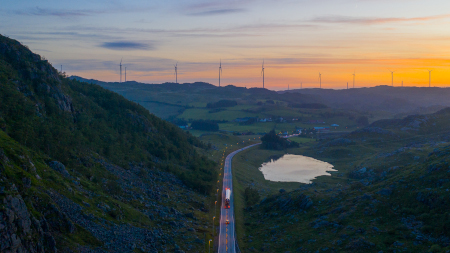Moving towards a low carbon future for the heavy industries is a hugely challenging endeavor. But it is an area in which we can make great progress towards limiting the worst impacts of climate change and meeting the goals set out by the Paris Climate Agreement. Mammoet's Head of Sustainability, Erica Gray, discusses engineered heavy lifting's role as an enabler of this transition.
"The difficulty lies not so much in developing new ideas but in escaping old ones" - John Maynard Keynes.
On the road to making the heavy industries carbon-neutral, our biggest hurdle is not the technical challenge, but the need to let go of "the way we've always done it". I believe embracing change, taking risks and becoming truly entrepreneurial in our approach is the route to creating a low carbon future.
Over the last couple of years there have been increasing calls for the world to switch to more sustainable economic models and practices. However, there is a big gap between this demand and what is currently practically possible.
According to the United Nations' annual 'emissions gap' report, global temperatures are currently on pace to rise as much as 3.2 degrees by the end of the century. This is significantly higher than the two degrees many countries have pledged to stay 'well below'. Yet, in the five years since the Paris Agreement carbon emissions have continued to rise.
Organizations such as the World Economic Forum and the development banks are urging governments to support the post-coronavirus economy by investing in infrastructure projects that are sustainable – through 'green stimulus packages'. There has been much speculation that this is our big chance to re-launch economies on a more sustainable footing.
However, there are many practical hurdles to overcome in satisfying an energy-hungry planet with limited resources. The kind of massive infrastructure change required to meet the Paris targets does not happen quickly and the reality is we will need to continue to satisfy the demand for power as we transition to low carbon solutions.
To navigate this transitional period many of the world's leading energy companies are setting out their plans for the future. Recent legal and shareholder actions are adding extra pressure to this process by demanding that the energy sector sets out more ambitious low carbon strategies and roadmaps.
The good news is we are not starting from scratch: there is much knowledge and experience that can be 'reused and recycled' for more sustainable applications. In this way, Mammoet's expertise from the traditional heavy industries can help our customers to meet their strategic sustainability targets and to create a whole new "greener" infrastructure.
For example, the experience we have built up in load-outs and heavy lifting offshore can be utilized for the efficient execution of wind projects - particularly floating wind, where foundations will reach over ten thousand tonnes. Modularization techniques - used to deliver more efficient construction for conventional industrial projects over the last three or four decades - will also enable the renewables sector to enjoy faster, safer and more cost-effective projects with potentially lower carbon footprints.
The wind industry can particularly benefit from expertise from conventional industry. As hub heights increase and wind turbine components grow ever-larger, technologies developed with different industries in mind will make a big difference. Super heavy lift cranes will help to broaden participation in wind energy by making more ports viable for offshore wind projects, while on land they will allow assembly of huge turbine structures and support the provision of the necessary infrastructure for power distribution networks.
And it doesn't end there. New facilities such as waste-to-energy plants, biofuel facilities or co-located steel and energy production plants can all benefit from highly efficient modularization techniques, supported by the heavy lifting know-how and equipment that have moved modules of over 40,000t.
Besides new construction, there are also opportunities for existing facilities to upgrade to more efficient techniques or to include carbon capture. The extensive experience our colleagues have accumulated on how to work in active, busy and constricted plants can be a huge benefit here – not to mention the highly-specialized gantries and cranes that have been developed for this purpose. In addition to enabling new infrastructure through more efficient solutions, heavy lifting and transport companies can help EPCs and owners to bring down the impact of their own operations by switching to low carbon equipment. Cranes and transport solutions that are hybrid or electrically powered, such as the electric SPMT or more efficient systems such as our Trailer Power Assist, can help bring more sustainable infrastructure online while reducing a project's carbon impact. This is of growing importance in the civil sector, where carbon emissions are closely monitored in line with governmental requirements to reduce the carbon footprint of publicly-funded projects. Working with low carbon fuels, such as biofuels or fuels derived from waste products, can reduce carbon emissions further. We have already completed our first project using fuel derived from waste cooking oil. Even preparing the ground on which you work can be done in a way that is less carbon emitting – through the use of innovative products such as Enviro-Mat. There are many ways in which Mammoet can enable the energy transition – especially by using our expertise from elsewhere in heavy industry to support the growth of renewable energy and help our customers de-carbonize existing ways of working. There is so much more to be discovered - if we are willing to embrace the new and take the bold step away from the old. By working with us early in project planning we can find ways to cut the carbon impacts of projects. We are open to new ways of working and combining expertise and perspectives to support the energy and heavy industries in becoming a big part of the solution to the climate crisis.

